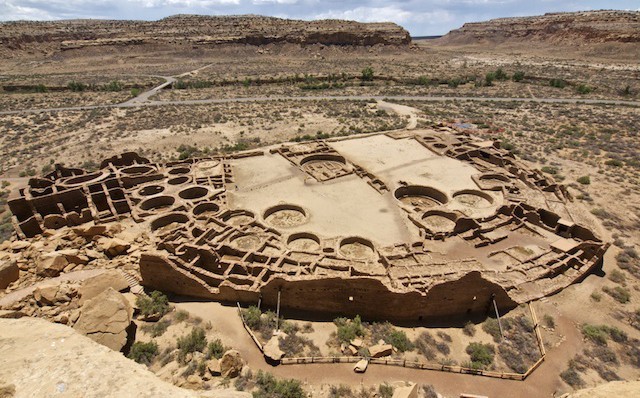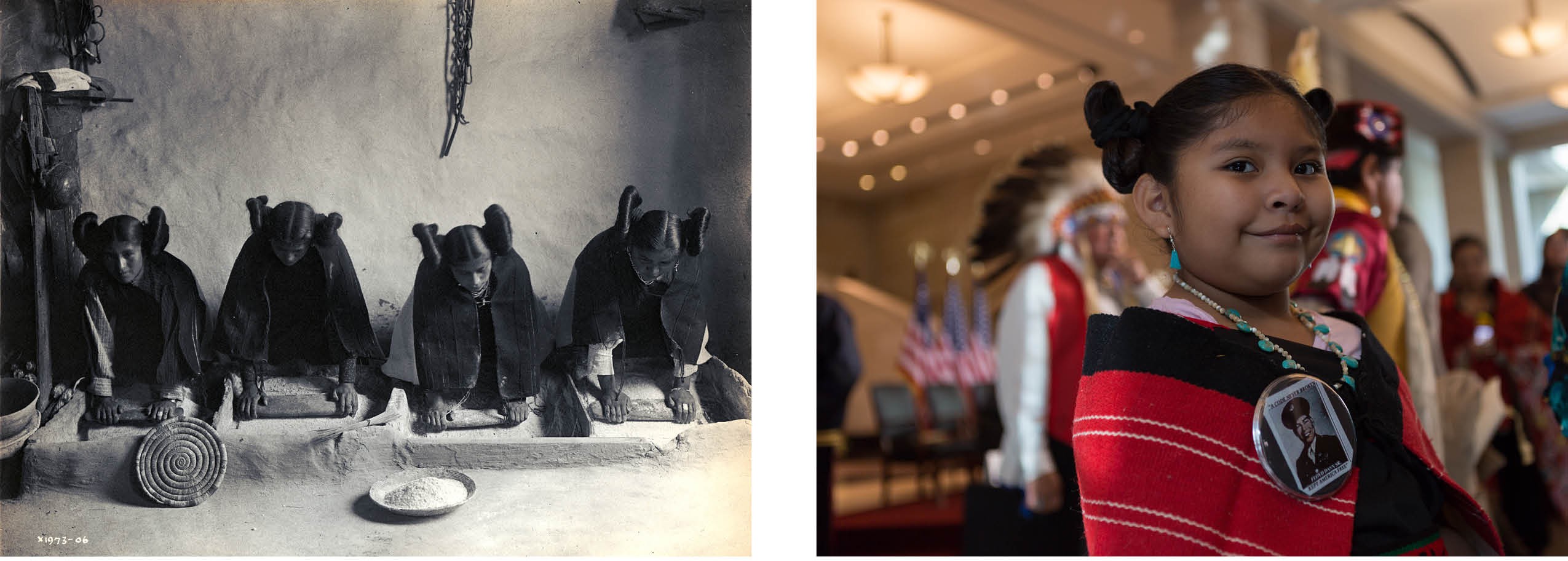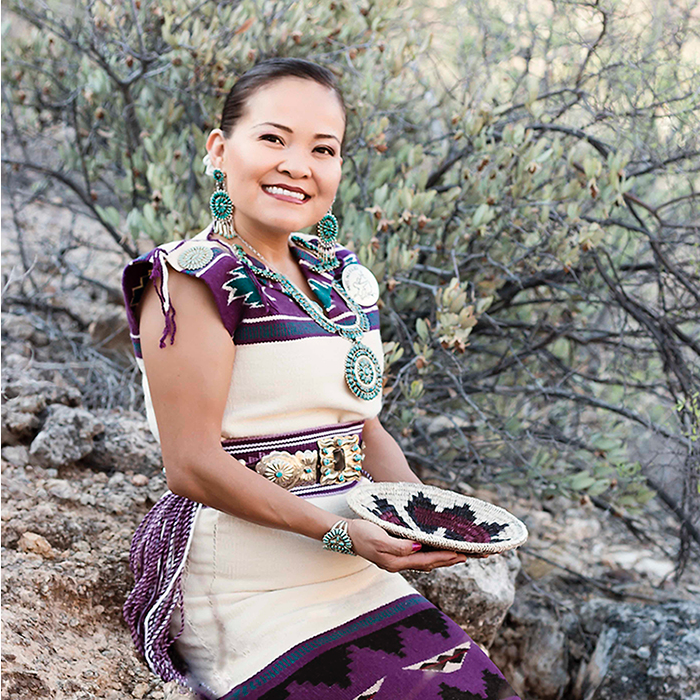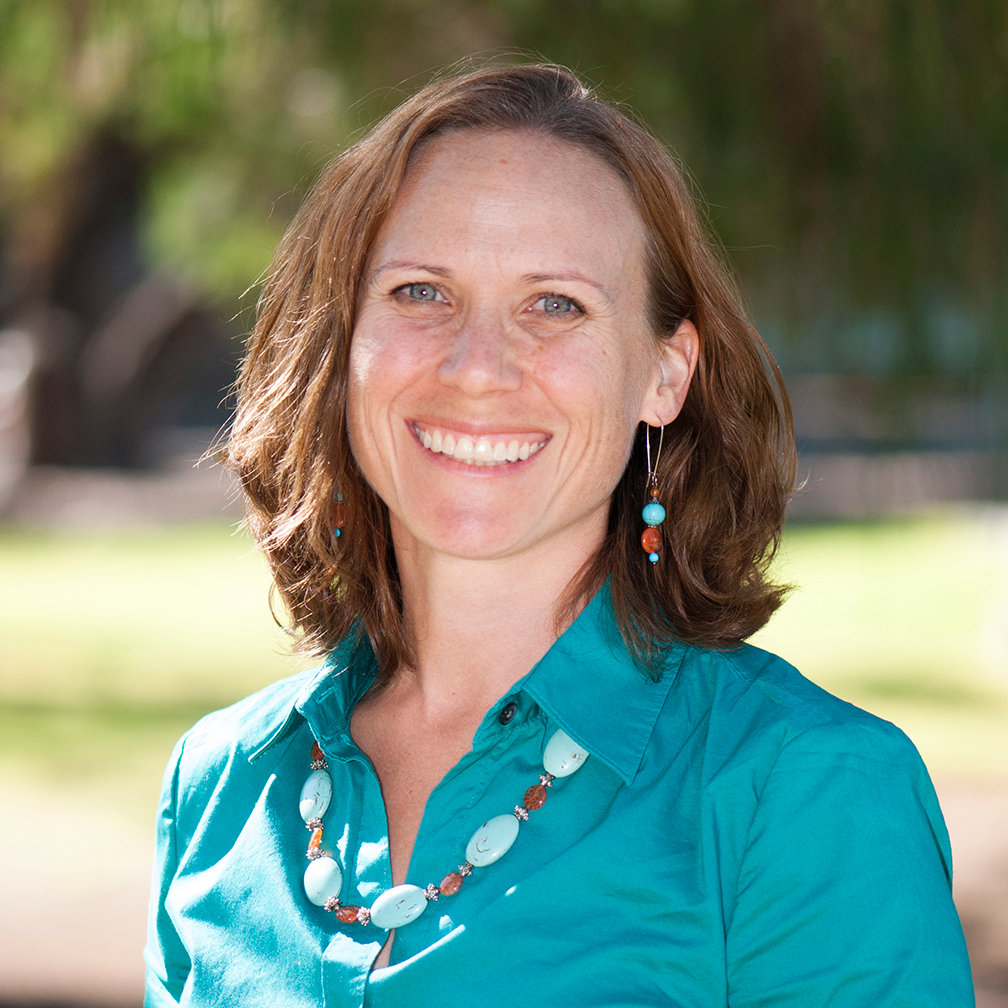 Pueblo Bonito - New Mexico © Sam Wise. The Anasazi built magnificent villages such as Chaco Canyon's Pueblo Bonito, a tenth-century complex. They successfully adapted to drier conditions and short intense thunderstorms during 900 and 1000 A.D. by introducing techniques of deep planting of seeds and technological innovation of water control structures and methods such as use of terraces to utilize runoff.
Pueblo Bonito - New Mexico © Sam Wise. The Anasazi built magnificent villages such as Chaco Canyon's Pueblo Bonito, a tenth-century complex. They successfully adapted to drier conditions and short intense thunderstorms during 900 and 1000 A.D. by introducing techniques of deep planting of seeds and technological innovation of water control structures and methods such as use of terraces to utilize runoff.
CLIMATE CHANGE is a hazard that will affect—and in fact already is affecting—communities around the world. It is a particularly damaging hazard for indigenous communities because of a combination of political and economic factors that have left them socio-economically vulnerable, and because climate change puts at risk the intimate relationships indigenous people maintain with their physical environments. Indigenous communities’ cultures, traditions and in some cases their very identities are based on the land and the sacred places that shape their world. Their respect for their ancestors and Mother Earth speaks of a unique value system different from some commonly held Western values, for example Christianity or Judaism.
As researchers, we would like to show how universities can play an important role in helping indigenous communities, namely Native American tribes, better understand and adapt to climate change. For instance, these institutions and their scientists can provide climate information, such as paleo-climate records, instrumental climate data, and climate model projections as well as tools for adaptation planning. However, it is critical that such information and tools be developed in collaboration with the communities themselves; they are the ones who will live with both the climate impacts and the adaptation decisions. In this article, we, at the University of Arizona (UA) Haury Native Nations Climate Adaptation Program (NNCAP) at the Center for Climate Adaptation Solutions, describe our experiences working with several Native American communities to meet their needs for climate information and support their efforts in planning for climate-change adaptation. In addition, having Native American perspectives is helpful in ensuring cultural sensitivities when working with tribes—Dr. Karletta Chief, Assistant Professor, is from the Navajo Nation in Arizona and the Project Coordinator of the NNAP, Mr. Chad Marchand is from the Coville Confederated Tribes of Washington.
Power of partnerships
Native American tribes are resilient; they have successfully adapted over time to environmental and ecological change through diversification of food and other resources, innovation of new technology, rich local knowledge about the area, and migration. For example, the Anasazi people adapted to drier conditions and short intense thunderstorms during 900 and 1000 A.D. in the Southwest by introducing techniques of deep planting of seeds and technological innovation of water control structures and methods such as use of terraces to utilize runoff (Baugh, 1994; Binman, 2008; Ben-David et al. 1974). The wisdom gathered through centuries of observations and passed down through generations provides a wealth of knowledge to contribute to effective adaptation strategies, such as earth-sheltered homes that use the earth for insulation, dry land farming, and use of drought resilient native seeds. However, only recently Western scientists have begun to place equal value on the traditional knowledge of tribes—for example, as a way to inform development of sustainable technologies or corroborate scientific data (Hiza, et al., 2014; Berkes 1998; Gearheard et al. 2010). Hiza Redsteer et al. (2014) interviewed Navajo elders regarding local environmental observations which were validated by scientific data but it also provided an extension of data to understand physical dimensions in the environment which were otherwise unobtainable (Hiza Redsteer et al., 2014). Many Native American tribes have practiced sustainable ways of living that is often community based and participatory that only recently has become more valuable by non-tribal people in climate mitigation and adaption. The integration of traditional knowledge into climate initiatives is promising. However, researchers wishing to integrate such knowledge into climate adaptation work must be aware of the potential risks that indigenous peoples face in sharing traditional knowledge and be aware of ethical protocols required to ensure the protection of traditional knowledge (Climate Change Working Group, 2013).
Since traditional knowledge is increasingly recognized, federal agencies and national climate change initiatives are funding collaborative efforts between indigenous communities and federal and non-indigenous climate change entities that involve traditional knowledge. In response to this, a large group of indigenous persons, staff of indigenous governments and organizations, and experts with experience working with issues concerning traditional knowledge developed guidelines on considering traditional knowledge in climate initiatives. Their goal was to establish guidelines so that non-indigenous centers and agencies can understand that the ultimate authority rests with the individual tribe and knowledge holders in whether or not to share traditional knowledge. Each tribe has their own unique authority for traditional knowledge, how the knowledge is transferred through time and space, and who may hold that knowledge. These guidelines were meant to inspire dialogue and questions, and to foster opportunities for indigenous peoples and non-indigenous partners to weave traditional knowledge and western science in culturally appropriate ways. Two key rules of ethical engagement are 1) ensure that researchers have obtained free, prior and informed consent from the community and 2) cause no harm. Tribes are sovereign nations who have the right to freely participate or disengage, and to fully know how their knowledge will be applied (Lomawaima 2000; Sahota 2007). An additional component of ethical engagement is the responsibility of researchers and their community partners to determine how to appropriately apply traditional knowledge to the question at hand (Ford et al. 2015; Huntington 2005).
Each tribe has their own unique authority for traditional knowledge, how the knowledge is transferred through time and space, and who may hold that knowledge
UA has a rich history of strong partnerships with tribes as well as a strong expertise in climate science and adaptation. Recently, the Native Nations Climate Adaptation Program (NNCAP) was developed by the Center for Climate Adaptation Science and Solutions (CCASS) within the Institute of the Environment at UA to work with tribes on climate adaptation. Through the examples of two projects, we discuss in this article the challenges and successes of working with tribes on climate adaptation and risk-management plans. The foundation for successfully working with tribes is built on a history of previous tribal university partnerships that were nurtured through the years both by the researchers and their collaborators working in tribal government and natural resource management. These experienced boundary spanners (those who actively bridge the gap between research and practice) apply an engaged approach to provide science support for tribes while following tribal research protocols and abiding by the ethical protocols.
Building trust with tribal communities includes open and consistent communication (in-person whenever feasible), transparency or process, and reporting results back. Because tribes may be approached by different researchers from different institutions, it is critical that we use our network to leverage existing efforts and avoid duplication. Building capacity of tribes includes recruiting Native American students to work on these projects and training them with the intent that they will work for their tribe at the completion of the academic pursuits in some capacity. In fact, NNCAP’s program coordinator is Native American and has a record of successful tribal engagement.
Two projects
The first project is a drought study with the Hopi Tribe, whose lands are located in the Four Corners region of the American Southwest, roughly at the intersection of Utah, Arizona, New Mexico, and Colorado. The Hopi Department of Natural Resources (HDNR) has been collaborating with UA researchers to develop a drought-monitoring framework to help HDNR address the drought impacts, such as to farming, ranching, and cultural traditions, that resource managers note have affected them for at least 15 years. The framework was developed using a collaborative research approach that included rapid assessment, organizational ethnography, and participant observation, as well as interviews and multiple discussions with Hopi citizens and employees over approximately five years. The goal of the project was to ensure that Hopi people’s concerns about drought, existing monitoring and knowledge practices, and capacity to respond to drought impacts were are the forefront of the effort.
 (L) Four Young Hopi women grinding grain © Edward S. Curtis 1906 (R) Alandra Duyongwa of the Hopi Tribe 2013 © Speaker John Boehner
(L) Four Young Hopi women grinding grain © Edward S. Curtis 1906 (R) Alandra Duyongwa of the Hopi Tribe 2013 © Speaker John Boehner
By relying on local knowledge and skills the drought-monitoring framework is designed to harness local data in ways that support local decisions, rather than relying entirely on instrumental data from external sources, which is sparse across Hopi lands. For example, the team noted that the current drought plan relied on data not readily accessible to HDNR staff, making it difficult to declare (or undeclare) drought. However, HDNR staff members were already collecting environmental status information through several programs, including water resources and range management that shed ample light on drought conditions in the region. The shift to locally controlled data, the team hopes, will place more control in the hands of local decision-makers and community members who are most affected by drought impacts (Ferguson et al. in review).
The second project involves the Pyramid Lake Paiute Tribe (PLPT). Researchers from UA, University of Nevada Las Vegas, and the U.S. Geological Survey have been collaborating with the PLPT in Nevada to identify vulnerabilities to climate change. When interviewed (by one of the authors, Alison Meadow) about their experiences working together, both the researchers and the tribal staff discussed important practices when researchers collaborate with tribes, particularly on sensitive issues involving water and water rights.
For example, although the PLPT does not have its own research review board, the lead investigator (author Karletta Chief) ensured that she had the support and consent of the tribal council by formally requesting their cooperation in the project. Also, she received a letter of support from the (then) tribal chairman that documented her permission to undertake the research and the tribe’s commitment to collaborating with her team. Throughout the project, the research team checked with PLPT staff to ensure that they were following community protocols regarding meetings, interviews, or other forms of data-gathering. They worked with PLPT staff to organize community meeting to ensure that local protocols were followed. A high degree of trust developed between the researchers and PLPT staff, which was demonstrated when the potentially sensitive issue of protected cultural knowledge came up in the course of the research. Rather than become a hurdle, both groups were able to discuss what to do with cultural knowledge, should it arise in interviews or other discussions, and come to an understanding.
 Pyramid Lake Nevada © Andrew 2007. The Lake is one of the most valuable assets of the Pyramid Lake Paiute tribe and is entirely enclosed within the boundaries of the tribe's reservation.
Pyramid Lake Nevada © Andrew 2007. The Lake is one of the most valuable assets of the Pyramid Lake Paiute tribe and is entirely enclosed within the boundaries of the tribe's reservation.
Tribal Leaders Summit on Climate Change
In December 2015, CCCAS and NNCAP hosted the first Tribal Leaders Summit on Climate Change: A Focus on Climate Adaptation Planning and Implementation. It was held at the University of Arizona in Tucson, Ariz., on November 12 and 13, 2015. The Summit aimed to convene tribal environmental managers and leaders who have approved climate adaptation plans to share experiences, lessons learned, and build support for wider tribal climate-adaptation planning and implementation work. Sixty people attended the Summit, including 20 tribal representatives from at least 19 tribes (including two tribal council women from the Village of Newtok, Alaska), 10 federal agency representatives, and 20 university representatives and students. In general, the tribal summit participants reflected very positively about the Tribal Summit (n=14; 9 tribal; 1 academic; 1 government; 1 other; 3 unknown/did not select a category). More respondents thought that the highlights and interest portions of the summit were the case studies of planning/implementation and the traditional knowledge discussions. Traditional knowledge was widely discussed. One participant observed:
"We have always adapted using traditional knowledge. The challenge now is to record it and integrate western science into our adaptation. We also need to help the rest of the world understand our knowledge and priorities" (Black et.al, 2015).
Some participants noted weaknesses in the Summit, however. For instance, they said, the breakout sessions were repetitive and should have had more native facilitators. Some complained that they wanted the Summit to include some topics that weren’t covered, such as energy and economic sustainability. The participants suggested that the Summit in the future include activities to facilitate internal partnerships within tribes and engagement of citizens to translate the concept of climate change. By communicating climate change to local context, communities can “acknowledge what’s there and empower people to deal with it” (Black at.al, 2015). Another suggestion was to link existing plans (like hazard mitigation or drought plans) with adaptation plans helps to overcome resistance. One theme that arose was the importance of monitoring and evaluating the success of implementation activities to facilitate improvement.
Building blocks for the future
This is a good starting point for NNCAP, suggesting potential to build upon these successful partnerships. We are currently developing tools such as a climate-adaptation profile that can provide tribes with the basic climate information necessary to start the adaptation-planning process—namely, analysis of past climate, current trends, and projected future climate. The next step in this process is to develop training materials for climate-adaptation planning that focus on the climate impacts and responses that are most relevant for each individual tribe. We are also continuing to train Native American students in climate-adaptation planning and climate science. In order to understand the needs of tribes, we are currently conducting a tribal adaptation needs assessment for tribes in the Southwest. The assessment will help us understand where tribes are in the process of climate adaptation, what their information and support needs are, and how we can develop culturally appropriate tools for climate adaptation. We have developed regional partnerships with other climate centers such as the Department of the Interior Southwest Climate Science Center and the National Oceanic and Atmospheric Administration-funded Climate Assessment for the Southwest (CLIMAS), which we hope will help us extend our capacity and reach to provide additional on-the-ground support for tribal climate adaptation efforts.
We would like to acknowledge Mary Black, Kathy Jacobs, Dan Ferguson, and Chad Marchand for their contributions in developing the framework of this article.
References
Baugh, T. 1994. "The Origins of Southwestern Agriculture" The American Indian Quarterly 21 Apr. 2016.
Ben-David, S., F.L. Brown Jr., W.D. Schulze, and J.E. Zamora. 1974. Water as a limiting factor in Indian economic development. Technical completion report, Project No. 3109-125, New Mexico Water Resources Research Institute.
Berkes, F. 1998. "Indigeous knowledge and resource management systems in the Canadian subarctic" Linking Social and Ecological Systems: Management Practices and Social Mechanisms for Building Resilience, F. Berkes, and C. Folke, Eds., Cambridge University Press, 98-128.
Black, M., K. Chief, K. Jacobs., S. Chew, and L. Rae. 2016. Native Nations Climate Adaptations Program Tribal Leaders Summit on Climate Change: A focus on climate adaptation planning and implementation. University of Arizona, Tucson, AZ, November 12-13, 2015.
Ferguson, D. B., A. Masayesva, A. M. Meadow, and M. A. Crimmins, in review: "Rain gauges to range conditions: Developing a local drought information system using locally relevant observations" Ford, J. D., E. Stephenson, A.C. Willox, V. Edge, K. Farahbakhsh, C. Furgal, S. Harper, S. Chatwood, I. Mauro, T. Pearce, S. Austin, A. Bunce, A. Bussalleu, J. Diaz, K. Finner, A. Gordon, C. Huet, K. Kitching, M. Lardeau, G. McDowell, E. McDonald, L. Nakoneczny and M. Sherman. 2016. Community-based adaptation research in the Canadian Arctic. Wiley Interdisciplinary Reviews: Climate Change, 7:175–191.
Gearheard, S., M. Pocernich, R. Stewart, J. Sanguya, and H. P. Huntington. 2010. "Linking Inuit knowledge and meteorological station observations to understand changing wind patters at Clyde River, Nunavut". Climatic Change, 100, 267-294.
Hiza Redsteer, M.H., K.B. Kelley, H. Francis, and D. Block. 2014. "Increasing Vulnerability of the Navajo People to Drought and Climate Change in the southwestern United States: Accounts from Tribal Elders." Indigenous Knowledge for Climate Change Assessment and Adaptation, Edition: In Press, Publisher: Cambridge University Press, Editors: Douglas Nakashima, Jennifer Rubis, Igor Krupnik.
Huntington, H. P. 2005. "We Dance Around in a Ring and Suppose: Academic Engagement with Traditional Knowledge" Arct. Anthropol., 42, 29-32.
Lomawaima, K. T. 2000. "Tribal Sovereigns: Reframing Research in American Indian Education" Harvard Educational Review, 70.
Sahota, P. C. 2007. Research Regulation in American Indian/Alaska Native Communities: Policy and Practice Considerations.

